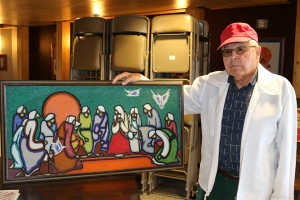Ephrem still inventive after all those years

NIPISSING FN – Ephrem Commanda has been a tree planter, a timber cutter and scaler, and a forest ranger, but he prefers to think of himself as an inventor.
The 76-year-old – who was born in a log cabin in Laronde Creek on Nipissing First Nation – has four patents registered with the U.S. patent office in Washington D.C., including ones for a foldable picnic table, a fluid-powered generator, a process for creating beaded artwork, and his latest and biggest dream invention: a self-sufficient home using energy created from recycled sources.
“I’m interested in anything to try and create work for our people,” says Ephrem, who says his creative energy is sometimes triggered by articles he reads in magazines like Popular Science or National Geographic.”It carries on in my dreams and then I write on it the next day.”
Ironically it’s the same multinational companies like the ones who employed him for 23 years in Espanola who stand to lose if his self-sufficient home idea pans out. Using locally-created materials – recycling everything, including biodegradable food waste—could reduce home prices by 70 per cent by eliminating so much wood in construction. He notes that indigenous peoples in the Southwest built adobe dwellings that have lasted for 3500 years.
“It could the big oil companies out of business,” he grins.
Ephrem remembers always being possessed of a natural curiosity.
“In high school I used to disturb a lot of people in chemistry class; I used to experiment a lot. One time there was an explosion when I was working with hydrogen. They used to call me the mad scientist!”
He spent much of his life in forestry, holding down a part-time job cutting wood when he was in high school.
“They used horses to haul the logs out of the hush in those days,” he recalls.
After being one of the first students to graduate from high school in Sturgeon Falls, Ephrem went to forest ranger school in Dorset, and then on to work in Espanola for companies like KVP, later Brown Forest, later E.B. Eddy, later Domtar.
Nobody called him a “mad scientist” when he designed retractable and removable wheels for snow machines, or created harvesting plans that helped preserve the natural resource.
In 1982 he began working for his First Nation in resource management, fish and wildlife, and now lives in the Garden Village reserve community in the house he inherited from his parents: Anastasia, who passed in 1994, and John, a veteran of both World Wars who died in 1988.
He hopes to see the day when his self-sufficient home concept creates total employment for his First Nation.
Meanwhile, he notes, inventing is not a way to get rich quick.
“There’s no money – yet,” he says. “Big companies are always trying to steal ideas, wiggle out of paying for good ideas,” which is why Ephrem has a lawyer fighting for his patents in Washington.
He does make a little spending money selling works of art he creates using his patented process of gluing down beads over painted scenes.
He once had the opportunity to show Leland Bell how he had transformed his oil painting of an Anishinaabe version of The Last Supper into a glistening piece of coloured beadwork.
“It took about 120 hours to make it and cost $200 in materials, “ says Ephrem. “He told me ‘Yours is better than mine’.”


